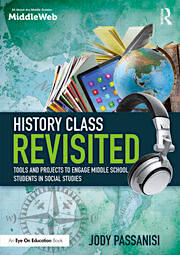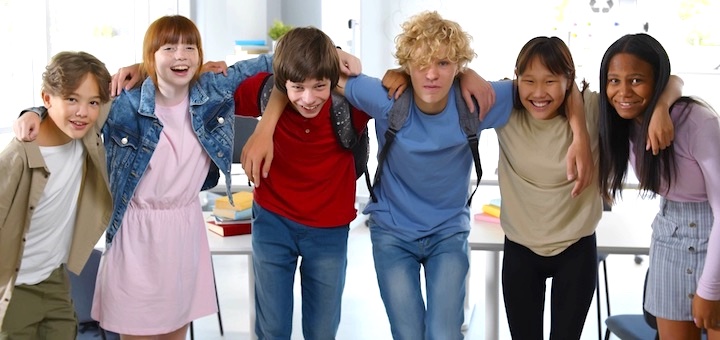It May Be Developmental and Still Not Appropriate
By Jody Passanisi
Spring is here in the Northern Hemisphere, and with it comes an increase in student activity, and not just of the academic sort. Drama is paramount in the middle grades during the spring months and heading into summer break.
With hormone fluctuations wreaking havoc on their bodies and minds, the last thing many middle graders are thinking about is the academic component of school.
In the past twenty-four hours alone, in my role as an administrator (grades 5-8) in a small independent California school, I have dealt with a slew of interpersonal issues that were a result of students not thinking before they spoke, misunderstanding context, creating drama, inserting themselves into others’ drama…and the list goes on.
Thankfully, in all these cases the truth was unraveled, perspectives heard, and feelings repaired as best as possible. Ultimately, the goal is that they learn from these mistakes made at this developmental watershed while they’re still middle schoolers.
Now, you may say (heck, I would say) that all of the behavior mentioned above is absolutely developmentally appropriate and hardly unexpected. True! These kinds of behaviors are totally predictable, developmentally appropriate, and on target for students this age.
But developmentally appropriate doesn’t mean appropriate appropriate.
Sometimes, as educators, we will use the umbrella term of developmentally appropriate behavior when we see things that are within the scope of what to expect at certain ages. In the same way that we would expect a toddler to tantrum occasionally, we expect students in the middle grades to:
- push back
- assert their will in a multitude of situations
- question rules
- start thinking abstractly
- pay more attention to social stimuli than academics
- start valuing their friends’ opinions above all others
- start creating cliques
- start talking about romantic partnerships
And most of this is both developmentally appropriate and totally acceptable.
But when things get out of hand and students hurt each other with their words by excluding others, by bullying on social media, or through relational aggression on the play yard, then – though developmentally appropriate it may be – it’s not appropriate appropriate.
Which means that students need a reset, they need boundaries, and they need to figure out how to make amends for anything that was broken in their relationships. Because that is where the learning is. It’s a developmentally appropriate engine light that says: something needs attention here. A lesson is required before they can continue being a person.
There is no real way to avoid these developmentally appropriate inappropriate behaviors; they are part of students testing and learning at this important stage in their growth and development. But there are ways to mitigate the impact, both by being proactive and quickly reactive when incidents do occur. And, ultimately, by reflecting on the whole process and thus turning challenge into opportunity.
► Be Proactive
Building empathy and teamwork skills is essential for student success generally, but even more so for the middle grader who is just coming into their own, figuring out who they are and want to be, and have a little bit more capability than they used to, but not enough to stop them from using it in the wrong settings.
I think of these kids as all of a sudden getting an upgrade of their car engine. They can go faster now, but their brakes haven’t been checked and the rest of the car is still a bit wonky. It will take a while for the rest of the car’s system to get with the program of the engine.
So as you come into spring, building in teamwork opportunities, both cerebral and physical, is key – not to mention reflection and practice of expected behaviors.
Communicating effectively with peers in a variety of different settings is a challenge that middle graders will inevitably face. Communication labs and exercises can helpful here. These activities can range from silly to serious, can focus more on speaking or more on listening, but they all put a spotlight on how we communicate with each other and why is vital to teach it explicitly at this age.
It’s likely middle graders haven’t done a ton of thinking about how they communicate in the first place and don’t often slow down to think before they speak. Any kind of spotlight on skills in this area will help them to be more aware of how they talk to people.
► Anchor in Schoolwide Expectations
Most schools also have behavior expectations or value statements that are unique to the school’s culture and help to galvanize the school around shared expectations. Our school’s three pillars are community responsibility, humility, and dignity/respect, so every conversation we have around the importance of treating and speaking to people in a certain way is anchored in these pillars.
Often kids this age need prodding to see the good in people. Catching students doing good around the schoolwide expectations and sharing and celebrating that in the community shows what the school values and makes the expectations more front and center for students.
► Mediate in small groups
Most schools have advisory programs or homerooms. This can be a good time to work with students in small groups so that they can identify their challenges and anticipate the ones they haven’t identified yet. Another tool at this age is open session where, in small groups and with teacher facilitation, students bring up challenges they are facing and their peers help them problem solve.
The goal here is twofold: first, students realize that they aren’t alone in having certain challenges, whether they are academic or social or at home. And second, they get used to being part of the problem solving process, gaining autonomy in figuring things out.
Listening circles can be very valuable here too. Like the Practice of Council at the Ojai Foundation, a listening circle can be a powerful tool for students to empathize with each other. Using a talking piece and structuring the conversation, each person gets a chance to share (or pass) about a thematically topical question or topic. Then, most important, they witness by sharing what they’ve heard. Students gain insight into others at a level that is hard to approximate in other scenarios.
► Partner with Families
It’s a triangle and all three corners are vital to success: families, students, and teachers/administration. Families may also be finding their student’s behavior challenging. They may not know how to manage the strong feelings their student is bringing them daily. Or perhaps their student has “shut down” and they don’t know if they are OK.
Effective communication is key among students, teachers, and parents, fostering open dialogue and prompt resolution of concerns. Teachers can help by sharing their experience and years of expertise with this age group, and parents can help by bringing to the table their years and depth of expertise about their child.
And the student is the most important piece of all. We can support them in helping them to right-size their concerns, giving them support but allowing them the space and opportunity to work things out.
► Approach in Dignity
This age group, as challenging as they can be sometimes, is so rewarding to work with. They have such a strong sense of justice, and they haven’t quite been jaded yet by experience.
While most of them at this age lack the executive functioning skills, capital, or network to create their own movements, they care deeply about causes. Schools can capitalize on this depth of feeling by offering coursework and opportunities for them to put this energy to positive use.
Our seventh graders do a year-long philanthropy project where they research a nonprofit, interview someone from the organization, and find out everything about it from financials and overhead to reach and impact – all the while fundraising for a culminating activity. At the end of the year, the students allocate all their funds to the organizations in a celebration where they share about their nonprofits and present a check to the organization.
The students are highly engaged in this project because they know it makes a difference. Their dignity has been respected because they have been tasked with doing something important, AND they are striving to bring dignity to others as well.
Students need to feel they are heard and that they are being treated as people who matter. They are much more likely to be able to shed the emotional funk of adolescence if they feel like the person in front of them really sees them. And sometimes that means we, their grown-ups, both teachers and parents, need to forgo the life lesson till later. That’s how we respect their dignity and meet their needs where they are.
Breathe! We will get through this.
Spring won’t last forever. Soon it will be end of the year crunch time, and we will be focused on graduations and finals and culminating projects. But for now, enjoy the blossoming vegetation and foliage and breathe the fresh air when the drama becomes too heavy in the ether.
And remember, all of this is developmentally appropriate for sure. But it doesn’t mean that students shouldn’t be guided to do better. We believe in them – and we show them we do by keeping expectations high. Students this age often rise to the expectations that are set for them. That is developmentally appropriate, too.
 Jody Passanisi is an educator with 20 years of experience. After teaching in third, sixth, and eighth grades, she has spent the last seven years as Director of Upper School (5-8) at Gideon Hausner, an independent school in Silicon Valley. She is the author of History Class Revisited and is one of the founding contributors to MiddleWeb’s “The Future of History” blog.
Jody Passanisi is an educator with 20 years of experience. After teaching in third, sixth, and eighth grades, she has spent the last seven years as Director of Upper School (5-8) at Gideon Hausner, an independent school in Silicon Valley. She is the author of History Class Revisited and is one of the founding contributors to MiddleWeb’s “The Future of History” blog.
Jody’s work has been published in Scientific American and Education Week, most often with her writing partner Shara Peters. Jody has an MA and MS in Education and is currently working on a book for middle grades parent and educators. Find her specific-to-the-middle-grades Instagram account @chaostocontext for more tips about working with middle schoolers.


































